
Okay, I admit it, I LOVE a nice sifted compost. The absence of rocks, twigs, leaves etc. make the virgin soil look perfect. I’ve had people marvel at how beautiful my planting beds look after running my compost and dirt through a screen. Yea, yeah, I know it isn’t necessary to screen compost before adding it to your garden, but the payoff is (now) worth the work.
I’ve tried quite a few ways of sifting compost, but most of them require a lot of back breaking lifting and shaking. Well, following an idea I got on the interwebs I modified the plans and made an incredible compost sifting device.
Here I am breaking my back. It doesn’t look like very much fun does it.
BEFORE
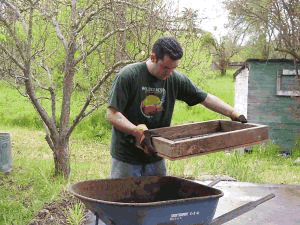
And here I am with my new sifting device. Boy is this MUCH easier than before! If I could just find a way to get past the shoveling of material into the screen and from the wheelbarrow I’d be home free.
AFTER
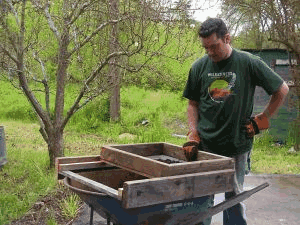
Here’s the screen I’m using. My dad calls it “expanded metal lath”. It is pretty small, but it was what was available around the house. Lots of work, but great lookin’ dirt. Biggest problem (besides the time) is that the worms don’t pass through so well.
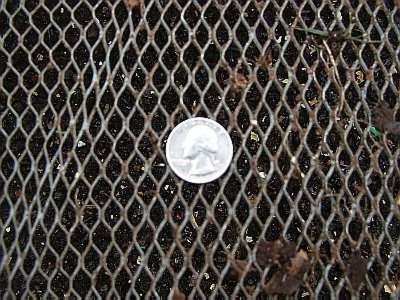
I think I’m going to go buy some strong 1/2 inch and 1 inch welded wire. 2 inch would be too big. I know because I have something that is about 1.5 inch and 99.9% of my compost goes right through it. Maybe that just means I have good finished compost? 🙂
The main changes I made to the design here was the change to the dimensions to fit perfectly lengthwise on my wheelbarrow and a lip that would keep it snug on the top of the wheelbarrow.
Future versions may include a feature that will provide for easy dumping of the left over compost / dirt into another wheelbarrow. I’m also going to make another screen with larger holes to filter compost that I’m not as worried about it looking perfect. I’m thinking about adding a system that will allow me to tip the top portion over the front of the wheelbarrow to easily dump out the non-screened material.
I’m also playing with the idea of “attachments” that will allow “hot swapping” of the screen size, but there may not be any reason to do that if one size fits all.
I’ll get some more plans / pictures posted once it stops raining.
UPDATE 3/24/05:
Here is the second version. I used some pvc chicken netting. I was worried about it being strong enough, but it seems to be holding up pretty well.
I made this one quite a bit bigger than the other one. The good news is that it can sift a LOT of stuff. Bad news is that it is heavyer to haul around and dump.
In the backyard I went to our leaf pile where we’ve been dumping leaves for years. Under about a foot of leaves is some stuff that looks like it is completely composted. I took my new sifter out there and filled up the wheelbarrow in a few minutes. All the leaves, twigs, roots, etc. were out in a jiffy.
Am I loving my soil too much? See my post on my Garden Forum
UPDATE 6/1/08: I’ve been bested! Look at this Automatic Compost Sifter – Screen
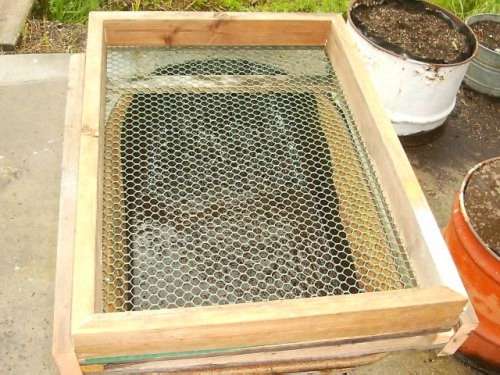
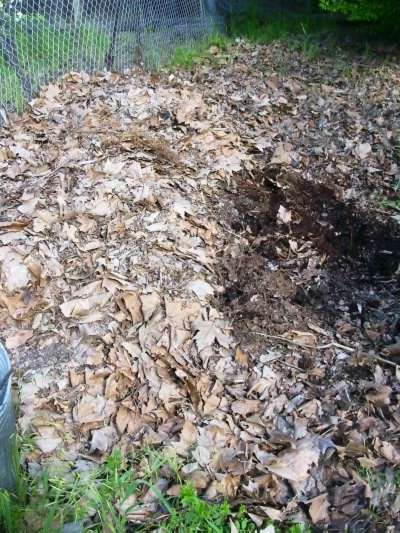
I don’t know if the author still reads this as it is some years later than this post however if so… Lowes post a home built version that like yours fits wheel barrows. It doesn’t have the options your s does but does have a pair of long handles that allow one to pick it up and down a few inches creating a rocking motion. I wonder if you or anyone has any ideas as to how one might combine the two affects effectively? I can build but lack creative design skills so any imput is apreciated. thanks, WV Powers
Hi William. Originally I was looking at up down motion for the sifter, but in general this motion consumes much more energy than side to side. Once I added wax to the sides there was very little friction and it didn’t take much effort to sift the material. The only issue I need to resolve is how to easily remove the material that is left behind after sifting.
I’d like to invent a revolving model that I can spin where the unsifted / large particles just fall out. That said, the convenience of this model that fits snugly over the wheelbarrow and requires little energy has been ideal.
After searching for a device that would work well for harvesting worms it looks like you have come up with a great solution. I don’t really compost but raise worms in peat moss and cow manure. I was wondering if you could give me an idea of what size wire I would need so the compost would fall through while the worms remain on the wire.
Thanks Roger
Roger, I’m not sure there is a great solution for you that would allow worms to remain behind. Worms (at least the ones we have) are pretty good at getting between tiny spaces, so I think it would be really hard to find the perfect screen that would leave them behind, but let all the compost remain. You could try a triple screen technique where you screen out the stuff bigger than worms and then screen out the worms from that stuff. I’d be concerned that this, or any screening would harm, or at least stress out the worms.
I have been searching for a sifter for Arson Investigations. I like your concept and would be interested in how much, and when you could send me one. You can call me at 800-742-2606 in Winchester, Va. It would seem to me tiny rollers on the bottom of the sifter would be effective to eliminate the friction problem.
Thanks,
Larry A. Peters
Larry, rollers is an interesting idea, especially for smoother and longer lasting use. In my mind I’m picturing in-line skates removed from the shoe and placed on the bed of the sifter.
For the most part, my design has worked great. Sanding the wood and adding the wax has made the sifter amazingly smooth. There are a few tweaks I’d like to make to the next design and will post them when I get a chance to implement them.
BTW, I don’t sell these, but am tickled by the request. I think you, or someone that has a little bit of woodworking skills could throw one together pretty quickly.
Rob,
Excellent idea…something my husband and I were talking about yesterday. We have a huge compost pile of mostly leaves and lawn clippings with nice ready soil underneath. All that is left is to sift it all (sounds like fun). We’ll have to try something similar to your solution. We have two wheelbarrows so we’ll both get to sift it. 🙂
Thanks for the idea!
Rob,
I am very interested in this, I sift soil for bonsai it is so tiring. I have multiple screen sizes 4 of which i made out of 1×4’s and 1/4,1/8, 1/2 and a fine window mesh. I am looking for a mesh size around 3/8. It is seemingly impossible to find what I am looking for. What is the approximate diameter of the opening of your chicken wire, and where abouts did you find it?
Ben, the metal lath is usually used for stucco work (at least that’s where we got it) and is probably close to 3/8. The PVC chicken “wire” is about 3/4 inch and I got it at the local “Home Depot”
I built one of these years ago to fit on my wheel barrow, I still use it today, it has grooves worn into it where it slides on top. I used 1/2” fencing screen and when I need potting soil I just drop in a 1/4” fence screen that fits inside. I’ve been thinking of a way to attached a mower engine to make it shake back and forth, the wheels are a great idea, although better suited to sit on saw horses since you add alot of extra weight with the tracks etc.
I also built a very large one of these about 3×6 feet and it sat off the ground 2 feet at the base and angled up at a 50 degree angle. I used it when I built my garden and front yard, I would just throw shovels of dirt at it and the rocks and garbage would just roll out the bottom and the dirt would sift through.
Great idea, i just built one like the first video yesterday. My arms are killing me. I will build the sliding frame tonight. Three years ago i build two composters, a simple wire circle of wire fenceing 6′ in diameter. I did not think it was composting, but when i removed the wire on my oldest one i was happy to find i have hundreds of pounds of very rich compost. So this idea is very much appreciated.
I live in a pretty wooded area of CT and every fall, forever we have blown all the leaves and twigs to the woodline. (mostly oak and maple) This spring I finally decided to put all those worms under there to work and began surfing incessantly on plans for composting and sifting compost. I built a 12′ x 12′ fenced in compost bin, a 2′ x 2′ enclosed bin, a 4′ x 12′ bin and piles here and there. I have also began rakeing, sifting, and loving all the worm poop left under the leaves. After I harvest the poop I re-cover the section, approx 10′ x 10′ with a new layer of material. Well I am hooked, I built a Trommel screener like the one shown and have sifted 4 55gal. drums worth of black gold compost and 4 55gal drums worth of pure worm poop. An ex-girlfriend gave me some commercially sold worm poop and my plants went crazy on the stuff. You can’t use too much!!! Now I am starting pure poop bins/ worm bins and love creating super soil for my yard.
http://welchwrite.com/agn/blog/2008/07/project-trommel-compost-sifter-from.asp
Wow, that is just fantastic! Here are the direct links:
http://www.instructables.com/id/Trommel-Compost-Sifter/
and my dream project:
http://www.flickr.com/photos/laj2006/541061869/sizes/l/
I’ve got a great idea to resolve the problem of friction/wear when sliding the sifter back and forth repeatedly: heavy-duty drawer slides with ball bearings. You might have to modify your frame a little, but it would be a lot less effort to sift the compost. You’ve still got the weight issue with dumping the material that doesn’t pass the screen, though. I was thinking maybe a multi-level compost sifter. Instead of a single level with 3/8″ mesh, you could temporarily affix another compost sifter with larger mesh (3/4″ mesh, for instance) on top of the one with mesh. This would cut the weight of refuse considerably since each level could be dumped separately. I would probably use a tri-tier arangement: 1″, 1/2″, and 1/4″. The drawer slides would only be attached to the sides of the bottom level. The upper level(s) could be attached to the bottom level with clamps.
I just saw an even better idea. Suspending the sifter from a frame with chains, like a swing. The only drawback is that you need an old swingset frame or two posts and a topbar.
If you mount the screen wire to the top of the frame, it is easier to dump by tipping up or clear with an upside down garden rake.
CASTERS instead of drawer slides – use 3-4 per side to prevent end to end tipping. Drawer slides will get clogged with dirt. mcmaster.com is a great place to start.
p/n 78155T17 $2.16 Each
p/n 9994T91 $4.38
DUMPING THE LEFTOVERS – hinge the board on the far end. Mount the screen to the inside wall of that board so it will pivot close to the same point as the hinge to prevent binding.
Good luck,
Paul
Paul, you’ve been reading my mind! Last Saturday I took the 8 wheels off of an old pair of roller blades. These things glide so smoothly they would work perfectly in this application… I just need to find a good way to mount them to the frame.
How to do pictures of a sort (hinge and castors) can be seen on my powered shaker on this, most excellent site…
Hi guys, here are a few ideas on power sifters
I throw pottery with “native” (dug locally rather than mined) clay and also am experimenting with castable refractories (need size-graded materials) and composting.
Several years ago I built a “shaker” (My father’s name for it) that was a wooden support frame with 2×4 uprights *inside* the horizontal box frames and a few inches shorter than the top rim. Think of an old box kite standing on end. An old washing machine motor that had been dropped and had a bent shaft was mounted on one side with the shaft passing horizontally through the top frame at a level such that when the shaft was rotated “down” it was level with the tops of the uprights.
The interchangeable shaker trays were 1×4 or 6 lumber with a hardware screen bottom secured by battens/furring strips (round the corners or the strips and roll the h-cloth under them, then between the frame and strip then over the strip and screw through the cloth/strip/cloth and into the tray to secure.
An additional beveled furring strip was screwed above the screen mounts to prevent material from accumulating on top of the edges of the screen.
The bent shaft acted as a cam to rattle the tray up and down. A piece of bed frame angle (which is annoyingly hardened steel) was used as a wear point to keep the tray from being damaged. “Next time” I’d weld up a cam of a few layers of bed frame angle metal and weld it to the shaft of a good motor.
A truck inner tube was split along the outer circumference as a funnel to direct the sifted stuff into big planter buckets.
Noisy (clatters) but effective.
Currently I’m making a light duty rotary sifter probably out of a big cable roll and h-cloth
Enjoy
Bob
Have you seen any plans for a trommel-style sifter? Made much like you have many years ago out of hardware cloth & scrap lumber. Kinda like to move up for very low bucks.
I am willing to purchase one. can you make one for me.
where can I buy one..
Would it be possible for bobdog to share some pictures of his “shaker”. It sounds like a good solution. Thanks.
Hi Rob
We required a more robust screener than the trommel to screen out the larger stones and branches and came up with this…
http://www.flickr.com/photos/laj2006/3504394415/sizes/l/
Lloyd
You are so close. Ues the wheels of roller blades to ride in a track and put a basket inside the tray that can be removed for emptying rocks and sticks.
Rob: Thanks so much! I built a sifter today based on your ideas, with a small modification: rather than having the two frames slide on one another, I put in some wooden wheels from my local woodworking store (Rockler). I attached them to the base with flange bolts, I think they’re called — they have a smooth shaft for part of their length, making them ideal for attaching the wheels. I have a pretty small wheelbarrow, so industrial strength bearings are not a concern for me. But just having a few points of contact reduces friction dramatically. Total cost was about $30.
–Bob
I was just sittin here readin and it occured to me that the boxes everyone has in mind are fine. Why not buy a oscillating vibrator that is used for vibrating concrete?
I dunno if it’d work but it seems to me it would…..they vibrate at varying speeds and i think they would make short work of sifting. Just hold it to the side of the box and viola!
A CONCRETE VIBRATOR SOUNDS LIKE A GOOD IDEA, BUT IT WOULD REALLY BE NECESSARY TO FASTEN IT SECURELY TO THE FRAME WITH U BOLTS. THE VIBRATION WHILE TRYING TO HOLD IT AGAINST THE FRAME WILL SHRED THE TENDONS IN YOUR FINGERS, HANDS AND WRISTS. I’VE HAD SURGERY ON BOTH HANDS BECAUSE OF DAMAGE FROM USING AIR HAMMERS AND JITTERBUG TYPE PNEUMATIC AND ELECTRIC SANDERS.
I built one using draw glides off an old kitchen cabinet. works super great.
Thank you!! This was such a life saver for me! I was doing the sifting the old fashioned way, with a screen and a large bucket, putting it in a wheelbarrow after wards. What a back-breaking effort that was! When I showed my husband that great video, a light bulb went off and he said he could make me one. He used some spare lumber we had and built a frame within a frame, with 1/2 inch mesh stapled to the top. It slides back and forth, and has handles at both ends, making removing the cover easier. He made it fit snugly over the garden cart, but can be lifted off. Again, this was a lifesaver and I love it!!
Has anyone looked at the posability of adding a hex drum to a cement mixer?
I am working on just such a sifter now, my thoughts are to make a hex drum that would bolt onto my cement mixer and provide an out board stand as a bearing to support the out board end, and wrap the whole thing in screen. and add a door on one side for filling.
Of course the interesting part is will have compost all over the yard slung from cintrifical force.
The mixer will not turn very fast so that should not be a problum.
Any imput would be helpfull.
Jigsaw
Swapping out the screens would be a good idea as sometimes you need finer particles of soil for different plants, so the soil does not retain too much water. ball bearings on the sides would reduce friction, and hardware cloth (available at your local hardware store) is the best for making sifters.
I made a sieving square with wood from pallets and chicken wire that laid on top of wheelbarrow….then used small hand fork to work it through mesh….I can fill barrow in less than 5mins ….I have 4 compost bins cubic meter each when 1 is ready use shovel to put compost in siever
the remains in the sieve go straight into the most recent compost unit ….now building enclosure for the 4 bins….
I’d be interested in buying the sieve. Do you sell them?
A quick,inexpensive and successful home-made Wheelbarrow Soil/Rock Sifter!
For the grand sum of $4.50 (including tax) – a 48″ x 50″ piece of Hardware Cloth 1/2″, spread over the wheelbarrow and held in place with a couple of Bungy Cords with folded edges, worked perfectly for a small project to remove soil from river rock .
get a old dryer, take out the heater, unbolt the bottom make a frame to hold the dryer up in the air, and put a bin or wheelbarrow under it. if the dryer doesn’t all ready have hole in the drum or if they arn’t big enough drill some holes. put your compost in with some golf balls and it will sift it and break up the clumps of dirt.
Re the letter to you, Rob, re the vibrating sifter… I made one briefly from a design of the net using my old jigsaw..made a piece to fit where the blade would go with a stopper at the end of the piece of old blade..set the sifter to it and it just works a treat.. and my old jigsaw has a new lease of life… the only reason my old jigsaw is doing that, my then wife bought me a new jigsaw for Christmas…. I mean the old one was only 10 years old then… lol… I have it set on a rig like yours… no doubt you have seen what I call the jigsaw sifters too…(I have the trigger on permanently on the jigsaw but have a safety pushbutton switch on the slide base, and an RCD plug at the power point)… but the guy who thought of it the jigsaw sifter idea needs a medal and saved me buckets of time… I changed my design as did one of your correspondents, so I could put different sized mesh in… and used those flip around fasteners you see holding up aluminium indoor fly mesh screens…
love the vids mate, looks like you’re having loads of fun
It was really good to find this design.
I made one last night from some reclaimed pallet lumber and some 1/2″ screen from a thrift store that I had laying around the garage.
I found that placing a 1″ diameter closet rod as a makeshift roller across the top of the frame (inbetween the frame and the tray, leaving 6″ to hang over on each side of the frame so it doesn’t fall off when rolled back and forth) lets the tray glide very easily. The roller is not fastened or kept in place by any mechanism, just the weight of the tray and friction that keeps it in place. Because the tray is now 4″ above the wheelbarrow it also give the ability to move the tray up and down, kind of like a teeter totter while rolling it back and forth. This was a simple and easy addition and seems to work well.
Seems like I’ve seen archaeologist on t.v. using some sort of sifter on their digs. Don’t know if these are the same. Just a thought.
I also built a very large one of these about 3×6 feet and it sat off the ground 2 feet at the base and angled up at a 50 degree angle. I used it when I built my garden and front yard, I would just throw shovels of dirt at it and the rocks and garbage would just roll out the bottom and the dirt would sift through.
Great Idea. I like the welded wire, or hardware cloth as people sometimes call it around these parts. It holds up really well. I’ve had one sifter of 1/2 inch hardware cloth for over 20 years and no rust. I will sometimes put a support bar underneath to keep the wire from sagging and tearing free. Not because it would if I’m using it, but because helpers are not always aware of things like that and will push on them etc… The hardware cloth comes in everything from 1″ down to 1/8″ and I have screens in all sizes plus two finer screens for sifting anything from compost to dirt, clay, sand, etc… My design is different, but could be adapted to your sled/cradle thing. thanks for the cool idea.
http://www.ci.glendale.ca.us/public_works/compost_screens.asp
This link still no longer works.
I thing better option is this compost sifter:
https://imgur.com/a/Wdygk
This is my home made and I can shake it in all directions.
I love your compost sifter/slider!
I too found the holes just a little smaller than i wanted. Discovered that the lath is very weak and it is easy to stick a really big screw driver through some of the hole, wriggle it around, and widen them. Do as few or many as you want.
Thanks Paul! I found an archive of the content: https://web.archive.org/web/20060829024508/http://www.ci.glendale.ca.us/public_works/compost_screens.asp